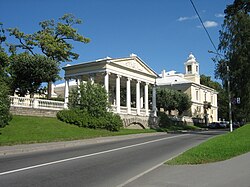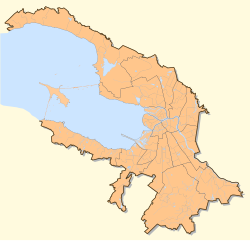| Revision as of 13:23, 16 November 2009 editMER-C (talk | contribs)Edit filter managers, Autopatrolled, Administrators250,829 editsm Reverted edits by 84.204.75.2 (talk) to last version by SmackBot← Previous edit | Revision as of 12:25, 13 December 2009 edit undoHouse1630 (talk | contribs)Extended confirmed users1,132 edits →Birthplace of Russian ScoutingNext edit → | ||
| Line 43: | Line 43: | ||
| <center><gallery> | <center><gallery> | ||
| Image:Pavlovsk palace.jpg|Palace in Pavlovsk | Image:Pavlovsk palace.jpg|Palace in Pavlovsk | ||
| Image:Apollo's colonnade.JPG|Pavlovsk park | Image:Apollo's colonnade.JPG|Pavlovsk park with bridge | ||
| Image:PavlovskPalace temple.jpg|Pavlovsk park |
Image:PavlovskPalace temple.jpg|Pavlovsk park: Friendship temple | ||
| Image:Pavlovsk 1001.jpg|Pavlovsk | Image:Pavlovsk 1001.jpg|Pavlovsk | ||
| </gallery></center> | </gallery></center> | ||
Revision as of 12:25, 13 December 2009
For other uses, see Pavlovsk, Saint Petersburg (disambiguation). Town in Saint Petersburg, Russia| Pavlovsk Павловск | |
|---|---|
| Town | |
 | |
 Flag Flag Coat of arms Coat of arms | |
| Location of Pavlovsk | |
  | |
| Coordinates: 59°41′N 30°26′E / 59.683°N 30.433°E / 59.683; 30.433 | |
| Country | Russia |
| Federal subject | Saint Petersburg |
| Founded | 1777 |
| Time zone | UTC+3 (MSK |
| OKTMO ID | 40387000 |
Pavlovsk (Template:Lang-ru) is a town situated in Russia, 30 kilometres (19 mi) from and under the jurisdiction of Saint Petersburg, just to the south of Tsarskoye Selo. Population: 14,960 (2002 census).
The town developed around the Pavlovsk Palace, one of the most splendid residences of the Russian imperial family. It is part of the World Heritage Site Saint Petersburg and Related Groups of Monuments.
The palace of Pavel I

The town's history started in 1777 when Catherine II granted some 362 desyatinas (977 acres; 395 ha) of land along the Slavyanka River to her son Paul upon the birth of his first child. The name Pavlovsk derives from Paul's name in Russian, Pavel.
In 1780, the fashionable Scottish architect Charles Cameron was made responsible for construction activities in Pavlovsk. His Neoclassical design for the Grand Palace was approved by Paul two years later. Around the palace a huge English park was laid out, with numerous temples, colonnades, bridges, and statues.
When Paul ascended the throne as Paul I in 1796, the settlement near the palace was large enough to be incorporated as a city. After Paul's death the palace was proclaimed a residence of his widow, Maria Feodorovna. Then it passed to the Konstantinovichi branch of the Romanov dynasty.
Later history

Prior to the revolution, Pavlovsk was a favourite summer retreat for well-to-do inhabitants of the Russian capital. The life of Pavlovsk's dachniki was described by Dostoyevsky in his novel The Idiot.
To facilitate transportation, the first railway in Russia was opened between St Petersburg and Pavlovsk on October 10, 1837. The railway station was used as a sort of concert hall, with Johann Strauss II, Franz Liszt, and Robert Schumann among many celebrities that performed there. The impressive 'Vauxhall Pavilion' is also used to attract customers to the railway line. Strauss' finer pieces resulted around the time he held his concerts there. The pavilion's fame eventually caused the word "Vokzal" to enter the Russian language with the meaning "substantial railway station building".
The Pavlovsk palace is probably the best preserved of Russian imperial residences outside the capital. The sumptuous neoclassical interior of the palace was faithfully restored after the great fire in 1803. The damage sustained by the palace during the German occupation in 1941–1943, though considerable, was not so devastating as in the case of Peterhof and Tsarskoye Selo.
Birthplace of Russian Scouting
On April 30, 1909 a young officer, Colonel Oleg Pantyukhov, organized the first Russian Scout troop Beaver (Бобр, Bobr) in Pavlovsk. In 1910, General Baden-Powell visited Nicholas II in Tsarskoye Selo and they had a very pleasant conversation, as the Tsar remembered it. In 1914, Pantyukhov established a society called Russian Scout (Русский Скаут, Russkiy Skaut). The first Russian Scout campfire was lit in the woods of Pavlovsk Park in Tsarskoye Selo. A Russian Scout song exists to remember this event.
References
- "Об исчислении времени". Официальный интернет-портал правовой информации (in Russian). 3 June 2011. Retrieved 19 January 2019.
- Cite error: The named reference
PopCensuswas invoked but never defined (see the help page).
External links
- Official website about the Pavlovsk palace
- Pavlovsk Palace and Park - by Kuchumov
- Pavlovsk - information on garden history and design
- Autumnal views of Pavlovsk
- The Pavlovsk Park views
- Photo (1024x768). The Pavlovsk Palace.
- Photo (1024x768). The Pavlovsk Park.
- Bernier, Olivier (1 October 1989). "Russia's Reborn Splendor". New York Times. Retrieved 2006-12-15.
| Russian imperial palaces and residences | |
|---|---|
| Imperial residences | |
| Grand ducal residences | |
| Outside the Russian Federation | |
| In Crimea | |
| Historical | |
| Cities and towns under the jurisdiction of Saint Petersburg | |||
|---|---|---|---|



